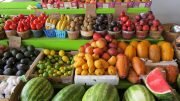Norwegians eat fish all year round, Christmas time included! In this article, we’ve compiled the five most common types of fish found on Norwegian dinner tables during the holidays.
Although most Norwegians swear by pinnekjøtt (dried mutton ribs) or ribbe (roasted pork belly) for their Christmas dinner, many also enjoy fish during the holidays.
These fish dishes are traditional Norwegian recipes and often span back several hundred years. To find out what they are, keep on reading!
Lutefisk
Lutefisk is possibly the most characteristic fish dish eaten in Norway, with records going back to at least the 16th century. Literally translating to “lye fish,” lutefisk is a meal composed of dried stockfish (usually cod, ling, haddock, or pollock) soaked in lye.
Preparation varies depending on where you are in the country. Boiled or baked, the most common way to serve it is with pea stew, boiled potatoes, bacon, and mustard. In Bergen, it’s common to have your lutefisk served with a side of turnip puree, while the people of Trøndelag prefer their lutefisk with syrup and brown cheese.
Read also: Your guide to Norway’s infamous “lutefisk”: Dried cod in lye
Rakfisk
Another fish dish with a punchy smell, rakfisk is a traditional Norwegian meal with roots dating back to the Middle Ages. It is usually made from freshwater species such as trout and char. The strong smell comes from the fish being salted and then fermented for two to three months, sometimes even up to a year.
When ready, it’s eaten without being cooked.
Many are reserved towards the dish due to its pungent smell. Still, if you want to give rakfisk a go, popular sides include lefser (traditional soft Norwegian flatbread), potatoes, picked red onions, sour cream, pepper, and fresh thyme.
Cod
Cod is commonly eaten in Norway all year long – however, it’s especially popular during Christmas time. Apparently, due to the cold and fresh water that the cod swims in during the winter, it’s extra tasty and firm come December.
In Norway, cod is usually prepared in hot water and served with traditional sides such as carrots, potatoes, and butter, although the variations are endless.
Gravlaks
Gravlaks directly translates to “buried salmon” and is a dish consisting of raw salmon marinated in salt, sugar, and dill. In the Middle Ages, gravlaks was made by fishermen who salted the salmon and fermented it by digging it into the sand above the high waterline, according to Meny. That certainly explains the name!
When being prepared today, gravlaks is usually placed in a mold in the fridge for 3-4 days. No digging necessary.
Herring
Herring, or “sild” in Norwegian, is a Christmas staple for many. The most common herring dishes in Norway during Christmas are tomato herring, ‘sour’ herring, and mustard herring, but the alternatives are numerous.
Although suitable for all meals, herring is especially great if you want to serve up a delicious traditional Christmas breakfast or lunch.
Source: #NorwayTodayTravel
Do you have a news tip for Norway Today? We want to hear it. Get in touch at info@norwaytoday.no


This traditional and delicious food is condemned, very soon, to stay in the books that belong to the past, and it is called to dissapear if we do not do anything with the new generations who grow up together with the fast food and with almost all their tastes of the food manipulated by the food industry around the world, using all the chemical flovour enhancers and all the additives in the food that our young generations are comsuming nowadays.
You only have to make young people to try natural flavours from natural and ecological products without artifitial chemicals and you will see as young people do not recognize these natural flavours as real becuase they are not the same as artifitial flavours they know from the fast food and the food products they ussually consume.
In another hand, local natural and fresh food can not almost compete in the same price conditions with fast food because fast food use the distribution network that globalisation has build up to produce food, sometimes in very poor countries and sometimes with important subsidies from the Governments and international institutions/ Organitations to the transport and other taxes which help directly or indirectly to the fast food to reach confortable our shops.
In addition we have to speak about the agressive publicity that fast food has behind and the lack of time of the families for cooking fresh and the model of socity we live in today.
But, can we do anything? The answer is yes. But we must want to do it.
I am an America of Norwegian descent living in Minnesota. My great grandparents on both my father and mother’s sides emigrated to Minnesota in the 19th century. Remembering our roots is a matter of pride and perseverance. I look forward to having Scandinavian food every Christmas holiday, including lutefisk and lefse and, of course, the wonderful variety of Norwegian pastries and cookies. Lutefisk suppers continue to be popular here in a surprising number of Lutheran churches. Come on over and join us next holiday season. We’d love to have you join us! Craig Shulstad
Ooops! I mean to say “American”